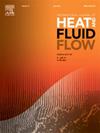Hydrothermal performance enhancement of heat sink using low flow-drag twisted blade-like fins
IF 2.6
3区 工程技术
Q2 ENGINEERING, MECHANICAL
International Journal of Heat and Fluid Flow
Pub Date : 2024-11-22
DOI:10.1016/j.ijheatfluidflow.2024.109669
引用次数: 0
Abstract
To prevent power equipment from breaking down due to overheating, an innovative design of twisted blade-like fins for heat sinks is proposed to enhance heat transfer efficiency and minimize pressure drop. The effects of the twist angle and different NACA airfoil cross-section of fins on the flow and heat transfer characteristics are investigated using numerical simulation methods over a Reynolds number range of 8548 to 34194. Comparing the twisted blade-like fins with cylindrical fins, the relative Nusselt number is 1.067–1.397, the relative friction coefficient is 0.528–1.339, and the hydrothermal performance factor (HTPF) is 1.155–1.552. The results demonstrate that the novel twisted blade-like fins substantially outperform cylindrical fins in terms of comprehensive thermal performance. Furthermore, the optimal design in the study is compared with the best design in similar studies, and the results show that the optimal twisted blade-like fins exhibit better advantages in drag reduction performance and HTPF. When Reynolds number is 34194, the twisted blade-like fins provide the highest HTPF of 1.552. The twisted blade-like fins stimulate spanwise and normalwise secondary flow, promoting fluid exchange between the wall and the channel core, thereby enhancing the heat transfer performance of the heat sink. Increasing the twist angle will improve heat transfer efficiency but increase pressure drop. Different cross-section shape can have different effects, and using NACA0009 airfoil cross-section yields better results in most cases. The twisted blade-like fins are effective in the field of heat transfer enhancement with low flow resistance of streamlined structure and strong heat transfer effect of secondary flow, greatly improving the comprehensive thermal performance of the heat sink.
利用低流动阻力的扭曲叶片式散热片提高散热器的水热性能
为防止电力设备因过热而发生故障,提出了一种用于散热器的扭曲叶片状翅片的创新设计,以提高传热效率并最大限度地减少压降。在雷诺数为 8548 到 34194 的范围内,采用数值模拟方法研究了翅片的扭曲角度和不同 NACA 翼面截面对流动和传热特性的影响。将扭曲叶片状翅片与圆柱形翅片进行比较,发现相对努塞尔特数为 1.067-1.397,相对摩擦系数为 0.528-1.339,水热性能系数(HTPF)为 1.155-1.552。结果表明,新型扭曲叶片状翅片的综合热性能大大优于圆柱形翅片。此外,研究中的最优设计与类似研究中的最佳设计进行了比较,结果表明,最优的扭曲叶片状翅片在减阻性能和 HTPF 方面表现出更好的优势。当雷诺数为 34194 时,扭曲叶片状翅片的 HTPF 最高,达到 1.552。扭曲的叶片状鳍片可刺激跨向和法向二次流,促进壁面与通道芯之间的流体交换,从而提高散热器的传热性能。增大扭曲角度会提高传热效率,但会增加压降。不同的截面形状会产生不同的效果,在大多数情况下,使用 NACA0009 机翼截面会产生更好的效果。扭曲的叶片状翅片在热传导增强领域效果显著,流线型结构流阻小,二次流传热效果强,大大提高了散热器的综合热性能。
本文章由计算机程序翻译,如有差异,请以英文原文为准。
求助全文
约1分钟内获得全文
求助全文
来源期刊

International Journal of Heat and Fluid Flow
工程技术-工程:机械
CiteScore
5.00
自引率
7.70%
发文量
131
审稿时长
33 days
期刊介绍:
The International Journal of Heat and Fluid Flow welcomes high-quality original contributions on experimental, computational, and physical aspects of convective heat transfer and fluid dynamics relevant to engineering or the environment, including multiphase and microscale flows.
Papers reporting the application of these disciplines to design and development, with emphasis on new technological fields, are also welcomed. Some of these new fields include microscale electronic and mechanical systems; medical and biological systems; and thermal and flow control in both the internal and external environment.
 求助内容:
求助内容: 应助结果提醒方式:
应助结果提醒方式:


